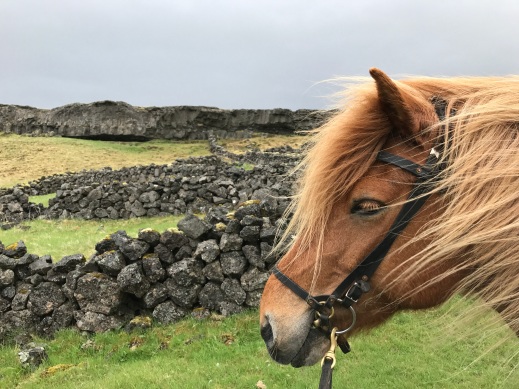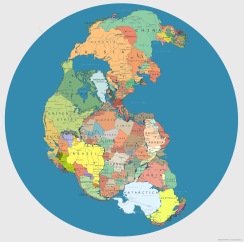Over 200 million years ago, there was a land known as Central Pangea, a land of towering mountains rivaling the Alps and the Himalayas.
Remnants, such as the Appalachians in North America, the Scottish Highlands, and the Atlas Mountains still exist, and since 1994, proponents have argued for the concept of an International Appalachian Trail (or Sentier International des Appalaches) that seeks to “reunit[e] what oceans are dividing.”

In fact, on the IAT’s website, one reads that, “At the 2012 IAT Annual General Meeting in Reykjavik, Iceland, the Iceland Touring Association’s Kjalvegur hinn forni (Old Kjalvegur hiking trail) became an official part of the International Appalachian Trail.”
As a native Appalachian and someone attempting to hike the “entire” Appalachian Trail from Georgia to Maine, I am perplexed. How is it that this internationally recognized trail is being expanded to include Iceland, a 20 million year old volcanic island along the Mid-Atlantic Ridge? And what does a name, or the identity of a place mean to the people who are from there, or to the people who come as tourists? How far back in time do we go to understand our global citizenry?

When I visited Iceland in the summer of 2017, I fell in love with the people, the culture, the horses, but especially the landscape. Being just one of the 2 million tourists projected to visit Iceland in 2017, I was immediately drawn to questions about belonging, both in terms of who belonged in Iceland and to what extent a place belongs to the people who have an interest in being there.

As a resident of a land where 3 million people from all over the world come annually to hike a trail running through the American region known as Appalachia, I am mystified by the suggestion that we could extend the name of this complex, misunderstood, and historically impoverished region to trails in Iceland and Europe.
My project brings together two geographically isolated regions, Appalachia and the Icelandic Highlands, by exploring the way place and identity are shaped by geologic time and personal experience, while also asking critical questions about tourism’s effect on local economies and fragile landscapes.
I use the word “fielding” to describe my process of exploration; a field is an area of knowledge but it is also a physical space that can be passed through. A field can be inhabited or grazed; it can also be fenced in, commanded, or closed off. A field is a place where boundaries are formed and also trespassed.
As a hiker, I pass through many fields, and so too as an essayist. Most importantly, a field is open to those inside, and though it may be symbolically or literally an enclosure, its edges are sometimes defined only by line of sight or some subtler vision.
My fieldings have usually happened on the page, excepting those times I have been a tourist in the States and abroad. The land of Central Pangea is invisible without both kinds of fielding; we can only see it if we allow geology to draw the lines of our earth’s histories. We recognize that politics and time draw different lines to describe the lives of human beings. Massimo Pietrobon’s world map of Pangea becomes a field into which we enter, now aware of how close we are to people who seemed so far away three minutes ago.


My intent is to see Central Pangea from as many fields as possible. After exploring the culture of thru-hiking on the Appalachian Trail, I intend to travel to Iceland to hike Kjalvegur hinn forni (Old Kjalvegur), then Laugavegur, and ride horses through the wilderness of the highlands during the summer of 2020. From there, an imagined center point, perhaps I will one day explore the rest of these mountains on both sides of the Atlantic.
My project is important because both the Appalachian Mountains and the Icelandic Highlands are vulnerable and also valuable; these are qualities that invite unintentional exploitation by the very people who come from all over the world to enjoy them. I believe that promoting awareness begins with immediate observation and study, in-depth and first hand.
At home in the United States, I am a backpacker and abide by the principles of Leave No Trace, which means that visitors to any natural place must work to protect the land by packing everything out, minimizing damage due to traffic, and being respectful of the residents, both human and nonhuman. Unfortunately not all visitors follow this ethic, and like many other people, I wonder about the hidden cost of Iceland’s tourism explosion, and how it fits into the larger framework of globalization.
Professionally, I am a writer and professor of creative or literary nonfiction. I traveled to Iceland in 2017 as a panelist at the NonfictioNow conference, hosted by the University of Iceland in Reykjavik. I spent two weeks in Iceland, and explored a little outside of the city, riding horses and getting to know more about the land and the people who live there. I was particularly curious about the surge of tourism generated by the “Inspired by Iceland” public relations campaign nearly a decade ago.
As a native of Appalachia, I feel qualified and compelled to consider my own questions about place and identity created by the imagining of the so-called “International” Appalachian Trail which includes areas of Iceland, Scotland, and mainland Europe. I have taught Appalachian literature and presented at a conference for Appalachian Studies. I feel that I have a solid grasp of what Appalachia is in contrast to the rest of America, an understanding of the region’s etymological origin, and I can say without hesitation that the concept of using the word “Appalachian” to describe a trail on the other side of the ocean seems like appropriation, though derived from the nomenclature of mountain building (orogenies) in geology. From what fields do we speak when we name a place?
In the same way that Icelanders marvel at the ridiculous assumptions that tourists make about Iceland, people in my part of the country shake their heads over what people believe about Appalachia. Some of it is true—there is much poverty and ignorance that comes with geographic isolation. But, as is true in Iceland, the strength and resilience of a people who have lived in an isolated place for generations is often obscured by myth. Do cousins marry cousins in Appalachia and do we wear shoes? Are there still outhouses and do people live in cabins? One may as well ask if there is an app to prevent Icelanders from marrying relatives, and whether everyone there believes in elves.
Iceland, at 39,682 mi², is slightly larger in area than the Blue Ridge Mountains, the part of Appalachia I call home, estimated to be 34,563 mi². The two National Parks in the Blue Ridge area are Shenandoah and the Great Smoky Mountains, which combined drew over 12.5 million visitors in 2016. As with Iceland’s Ring Road and Golden Circle, visitors from all over the world primarily see the landscape of these parks by car, either via Skyline Drive or the Blue Ridge Parkway. This comparison is useful for my project because how a landscape is experienced affects how the environment is preserved. Given the number of tourists now coming to Iceland, the people there are having to find new ways to manage resources that natives and non-natives share. Although tourism is a boon to places that offer natural wonders, what is the final cost for the people who make their homes there?
Tonally, my hopes are that I can approach serious concerns with a light-hearted curiosity and a willingness to inhabit this fantasized middangeard, a hypothesized field of geologic time and orogenies without falling into parody. I think it is fruitful whenever we find ways to connect to cultures distinct from our own, and laugh at the folly of naming, of owning, of possessing something as old as our Earth, a place that has been divided, folded, lifted, and imagined in ways surpassing human experience.
